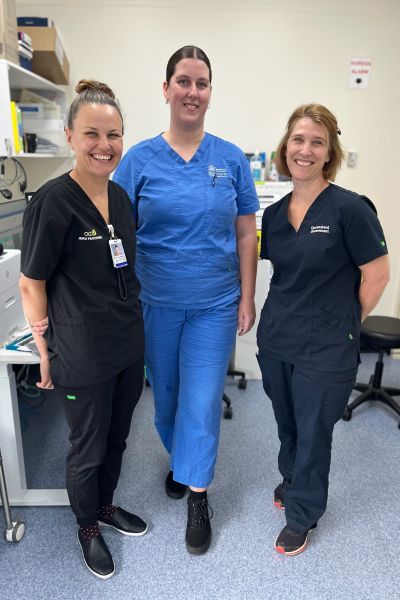Supported exercise intervention to prevent parastomal hernias

Wound Management and Stoma Care Nurse Practitioner Monica Stankiewicz, Enrolled Nurse Tahlia Lee and Wound Care Nurse Practitioner Anna Colquhoun.
An investigation into parastomal hernia prevention has shown that patient fear and limited medical understanding and advice can lead to lower patient outcomes.

Wound Management and Stoma Care Nurse Practitioner Monica Stankiewicz, Enrolled Nurse Tahlia Lee and Wound Care Nurse Practitioner Anna Colquhoun.
Community and Oral Health Wound Management and Stomal Therapy Nurse Practitioner Monica Stankiewicz said the research found that poor advice regarding return to activities such as lifting and exercise interventions was generally offered post-operatively to individuals after stoma formation.
“People living with a post-surgery stoma (ostomates) should undertake an abdominal exercise program to improve quality of life to reduce further complications,” Monica said.
“Decreased activity levels are observed in those after stoma formation, and deconditioning and low levels of exercise are factors in the development of parastomal hernia.
“This is complicated by a lack of evidence around the importance of exercise to prevent parastomal hernia or its complications.”
Recently, a survey of 105 adults living with stoma in Australia was conducted to explore exercise undertaken, advice they were given about exercise, and the willingness of patients to do a supported exercise program.
“The research showed that patients with a stoma are not receiving evidence-based information to effectively return to daily activities and exercise,” Monica said.
“Fear also played an important role in the amount of exercise completed by patients with a hernia.
“Nearly two-thirds of the 105 surveyed participants indicated concern around injuring themselves or causing a parastomal hernia if they were to perform an exercise routine.”
The study found fear avoidance in completing rigorous exercise, abdominal exercise and heavy lifting, coupled with poor advice, led to poorer health outcomes for participants.
The parastomal research has led to Community and Oral Health developing an appropriate core abdominal exercise program co-designed with patients, physiotherapists and communication experts.
The research study was conducted between Community and Oral Health, Griffith University, the University of Queensland and Australian Catholic University.
The survey results reported are one of three programs of research that have been conducted within Community and Oral Health.
Monica and her team continue to work on data analysis and plan to submit two other programs for publication.
Metro North Community and Oral Health delivers a nurse practitioner-led chronic wound and stoma service at Chermside Community Health Centre, which provides clinical care for prevention, assessment and management of wounds and stomal care.
The service implements care plans and works with GP nurses, community organisations, patients and their families to support the patient in the community setting.
The research findings have been submitted for peer review to a leading nursing journal.
